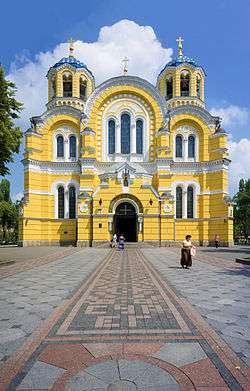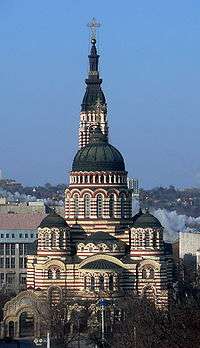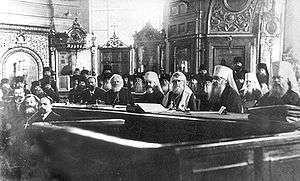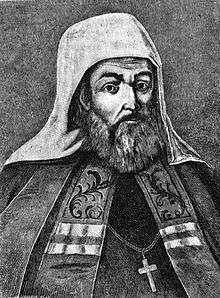Ukrainian Orthodox Church (Moscow Patriarchate)
| Ukrainian Orthodox Church | |
|---|---|
|
| |
| Founded | 1990 (self-rule within the Moscow Patriarchate) |
| Recognition | Recognized by majority of canonical Orthodox Churches as Autonomous Church (Not longer recongised as Autonomous Church by Ecumenical Patriarchate of Constantinople)[1] |
| Supreme Governor | Patriarch Kirill |
| Primate | Metropolitan Onuphrius |
| Polity | Russian Orthodox Church |
| Headquarters |
Kiev Cave Monastery Cathedral of the Resurrection of Christ[2] (under construction since 2007) |
| Territory | Ukraine |
| Language | Church Slavonic, Ukrainian, Romanian |
| Members |
17.4% of religious population (by Razumkov Center, January 2015)[3] 20.85 of religious population (by Ukrainian Sociology Service and Kucheriv democratic initiatives fund, December 2014 – January 2015)[4] |
| Bishops | 85 (53 governing) |
| Priests | 11,312[5] |
| Parishes | 12,069 |
| Monastics | 4,412 |
| Monasteries | 251 |
| Nuns | 2,727 |
| Website | Ukrainian Orthodox Church |


The Ukrainian Orthodox Church (UOC; Ukrainian: Українська Православна Церква, translit. Ukrayinsʹka Pravoslavna Tserkva, Russian: Украинская Православная Церковь, translit. Ukrainskaya Pravoslavnaya Tserkov'), commonly referred to as the Ukrainian Orthodox Church of the Moscow Patriarchate (Russian: Украинская православная церковь Московского патриархата) is one of the three major Eastern Orthodox ecclesiastical bodies in modern Ukraine and the only one that enjoys recognition by the other Orthodox Churches. It is a constituent part of the Russian Orthodox Church (ROC, i.e. the Moscow Patriarchate); however, the Ecumenical Patriarchate, the senior-most of all the Orthodox Churches and the mother church for the historical Russian Church, disputes the legality of the ROC's ecclesiastical jurisdiction over Ukraine, which in the modern era dates back to 1686.[6][7][8] The current statute of the ROC defines it as a "self-governing [church] with the rights of wide autonomy".[9] The current status of the UOC within the Moscow Patriarchate means that it enjoys full administrative independence from the ROC's Holy Synod, whereas the Primate of the UOC is the senior-most[10] permanent member of the ROC's Holy Synod and thus has a say in its decision-making in respect of the rest of the ROC, including its business in the Russian Federation.
Russia's annexation of Crimea in 2014 notwithstanding, the UOC's eparchies in Crimea continue under the administration of the UOC.[11]
History
Ecumenical Patriarchate of Constantinople
Moscow, Lithuania, Halych metropolia
The Ukrainian Orthodox Church considers itself the sole descendant in modern Ukraine of the metropolis of Kiev and all Rus' within the jurisdiction of the Ecumenical Patriarchate of Constantinople established in Kiev in the 10th century. Due to invasion of the Mongols in the 13th century the metropolitan seat was moved to Vladimir and later to Moscow, while in the Duchy of Halych and Volhynia was created a separate Metropolis of Halych with own Metropolitan. In the 14th century, the Grand Duke of Lithuania Algirdas who established his control over the former territories of Kievan Rus attempted to move the metropolitan seat back to Kiev.
Revival
In 1596, the Metropolitan of Kiev, Halych and all Rus' Michael Rohoza accepted the Union of Brest transforming dioceses of the Ecumenical Patriarchate of Constantinople into the Ukrainian Greek Catholic Church under the Holy See's jurisdiction. In 1620, the Ecumenical Patriarchate of Constantinople Cyril Lucaris reestablished Orthodox dioceses for the Orthodox population of what was then the Polish–Lithuanian Commonwealth — under the Metropolitan of Kiev, Galicia and all Russia Job Boretsky as the Patriarchal Exarch.
Merger into the Moscow Patriarchate
Following the transfer of the Cossack Hetmanate under the sovereignty of the Tsardom of Russia in 1654, the Kievan metropolis in 1686[12] was transferred by the Patriarch Dionysius IV under the jurisdiction of the Moscow Patriarchate, following the election of Gedeon Svyatopolk-Chetvertynsky as the Metropolitan of Kiev, Galicia and all Russia with the help of the Hetman of Zaporizhian Host Ivan Samoylovych. Thereafter, Gedeon gradually lost control of the dioceses which had been under the jurisdiction of the Metropolitan of Kiev. In January 1688, Gedeon's title was changed by Moscow to the ″Metropolitan of Kiev, Galich and Little Russia″. Gedeon's successors were effectively mere diocesan bishops under the Moscow Patriarchate and later Russia's Most Holy Synod.
Before the Battle of Poltava when Ivan Mazepa sided with Carl XII, the new Metropolitan Ioasaf along with bishops of Chernigov and Pereyaslav was summoned by Peter the Great to Glukhov where they were ordered to declare an anathema onto Mazepa. After the battle of Poltava, in 1709 Metropolitan Ioasaf was exiled to Tver and in 1710 a church censorship was introduced to the Kiev metropolia. In 1718 Metropolitan Ioasaf was arrested and dispatched to Saint Petersburg for interrogation where he died.
From 1718 to 1722 the Metropolitan see in Kiev was vacant and ruled by the Kiev Spiritual Consistory (under the authority of the Most Holy Synod); in 1722 it was occupied by Archbishop Varlaam.
Synodal period
In 1730, Archbishop Varlaam with all members of the Kiev Spiritual Consistory were put on trial by the Privy Chancellery. After being convicted, Varlaam as a simple monk was exiled to the Kirillo-Belozersky Monastery in Vologda region where he served a sentence of imprisonment of 10 years. After the death of the Russian Empress Anna in 1740, Varlaam was allowed to return and recovered all his Archiereus titles. He however refused to accept back those titles and, after asked to be left in peace, moved to the Tikhvin Assumption Monastery. In 1750 Varlaam accepted the Great Schema under the name of Vasili and soon died in 1751.
In 1743, the title of Metropolitan was re-instated for Archbishop Raphael Zaborovsky.
On 2 April 1767, the Empress of Russia Catherine the Great issued an edict stripping the title of the Kievan Metropolitan of the style "and all Little Russia".[13]
Fall of monarchy in Russia and Exarchate

During the advance of the Soviet troops on Kiev (see Ukrainian–Soviet War), in January 1918 was killed the Metropolitan of Kiev Vladimir Bogoyavlensky by unknown people. Metropolitan Bogoyavlensky chaired the All-Ukrainian Church Council that took a break between its sessions on 18 January 1918 and was to be resumed in May 1918. On 23–24 January 1918 the Red Guards of Reinholds Bērziņš occupied the city of Kiev. In the evening of 25 January 1918 Metropolitan Vladimir was found dead between walls of the Old Pechersk Fortress beyond the Gates of All Saints.
In May 1918 to the Kiev eparchy was appointed Metropolitan of Kiev and Halych Antony, a former candidate to become the Patriarch of Moscow at the Russian Local Council of 1917 and losing it to the Patriarch Tikhon. In July 1918 Metropolitan Antony became the head of the All-Ukrainian Church Council. Eventually he sided with the Russian White movement supporting the Denikin's forces of South Russia, while keeping the title of Metropolitan of Kiev and Halych. After the defeat of the Whites and the exile of Antony, in 1919-21 the metropolitan seat was temporarily held by the bishop of Cherkasy Nazariy (also the native of Kazan). After the arrest of Nazariy by the Soviet authorities in 1921, the seat was provisionally held by the bishop of Grodno and newly elected Exarch of Ukraine Mikhail, a member of the Russian Black Hundreds nationalistic movement. After his arrest in 1923, the Kiev eparchy was provisionally headed by various bishops of neighboring eparchies until 1927. After his return in 1927 Mikhail became the Metropolitan of Kiev and Exarch of Ukraine until his death in 1929.
In 1945, after the integration of Zakarpattia Oblast into USSR, eastern parts of the Eparchy of Mukačevo and Prešov were transferred from the supreme jurisdiction of Serbian Orthodox Church to the jurisdiction of the Exarchate of Russian Orthodox Church in Ukraine, and new Eparchy of Mukačevo and Užgorod was formed.
Dissolution of the Soviet Union and self rule
On 28 October 1990,[14] it was granted a status of a self–governing church under the jurisdiction of the ROC (but not the full autonomy as is understood in the ROC legal terminology).
Metropolitan Vladimir (Sabodan), who succeeded Filaret (Denysenko), was enthroned in 1992 as the Primate of the UOC under the title Metropolitan of Kiev and all Ukraine, with the official residency in the Kiev Pechersk Lavra, which also houses all of the Church's administration.
The church is currently the only Ukrainian church to have full canonical standing in Eastern Orthodoxy, and operates in full communion with the other Eastern Orthodox Churches. The UOC (MP) claims to be the largest religious body in Ukraine with the greatest number of parishes churches and communities counting up to half of the total in Ukraine and totaling over 10,000. The UOC also claims to have up to 75 percent of the Ukrainian population.[15] Independent surveys show significant variance. According to Stratfor, in 2008, more than 50 percent of Ukrainian population belong to the Ukrainian Orthodox Church under the Moscow Patriarch.[16] Razumkov Centre survey results, however, tend to show greater adherence to the rival Kiev Patriarchate.[17] Many Orthodox Ukrainians do not clearly identify with a particular denomination and, sometimes, are even unaware of the affiliation of the church they attend as well as of the controversy itself, which indicates the difficulty of using survey numbers as an indicator of a relative strength of the church. Also, the geographical factor plays a major role in the number of adherents, as the Ukrainian population tends to be more churchgoing in the western part of the country rather than in the UOC (MP)'s heartland in southern and eastern Ukraine. Many in Ukraine see the UOC-MP as merely a tool of the Putin Government.
The number of parishes statistics seems to be more reliable and consistent even though it may not necessarily directly translate into the numbers of adherents. By number of parishes and quantity of church buildings, the UOC (MP)'s strong base is central and northernwestern Ukraine. However, percentage wise (with respect to rival Orthodox Churches) its share of parishes there varies from 60 to 70 percent. At the same time, by percentage alone (with respect to rival Orthodox Churches) the urban russophone southern and eastern Ukrainian provinces peak with up to 90 percent of church buildings. The same can be said about Transcarpathia, although there the UOC's main rival is the Greek Catholic Church and thus in all its share is only 40 percent. The capital Kiev is where the greatest Orthodox rivalry takes place, there the UOC (MP) has only half of the Orthodox communities. The only place where the UOC (MP) is a true minority, in both quantity, percentage and support are the former Galician provinces of Western Ukraine. There the total share of parishes does not exceed more than five percent. The UOC (MP) does not have any parishes abroad, as its followers identify themselves under the same umbrella as those of the Russian Orthodox Church.
As of 2006 the Ukrainian Orthodox Church had the allegiance of 10,875 registered religious communities in Ukraine (approximately 68 percent of all Orthodox Christian communities in the country), located mostly in central, eastern and southern regions and claims to be the largest religious body in terms of church property in Ukraine.
Since 2014 the church has come under attack for perceived anti-Ukrainian and pro-Russian actions by its clergymen.[18] On 14 September 2015 it urged the pro-Russian separatists of the War in Donbass to lay down their arms and take advantage of the amnesty promised to them in the Minsk II agreement.[19] Ukraine passed laws which the Moscow Patriarchate interpreted as discriminatory in 2017.[20] From 2014 until 2018 around 60 Moscow Patriarchate parishes switched to the Kyivan Patriarchate in transfers the leadership of the Moscow patriarchate says were illegal.[21] According to the Razumkov Center, among the 27.8 million Ukrainian members of Orthodox churches, allegiance to the Kyiv Patriarchate grown from 12 percent in 2000 to 25 percent in 2016 and much of the growth came from believers who previously did not associate with either patriarchate.[22] In April 2018 Moscow patriarchate had 12,300 parishes and the Kyivan Patriarchate 5,100 parishes.[21]
By decision of the Russian Orthodox Church Bishops’ Council (November 29-December 2, 2017), a separate chapter of the ROC Statute was singled out to confirm the status of UOC with the following provisions:
- 1) The Ukrainian Orthodox Church is granted independence and self-governance according to the Resolution of the Bishops’ Council of the Russian Orthodox Church which took place on October 25-27, 1990.
- 2) The Ukrainian Orthodox Church is an independent and self-governed Church with broad autonomy rights.
- 3) In her life and work the Ukrainian Orthodox Church is guided by the Resolution of the 1990 Bishops’ Council of the Russian Orthodox Church on the Ukrainian Orthodox Church, the 1990 Deed of the Patriarch of Moscow and All Russia and the Statute on the governance of the Ukrainian Orthodox Church.[5]
In December 2017 Security Service of Ukraine lifted classified top secret status of documents reveals that the NKGB of the USSR and its units in the Union and autonomous republics, territories and regions were engaged in the selection of candidates for participation in the council from the representatives of the clergy and the laity. To this end, it was necessary to outline "persons who have religious authority among the clergy and believers, and at the same time checked for civic or patriotic work".
"It is important to ensure that the number of nominated candidates is dominated by the agents of the NKGB, capable of holding the line that we need at the Council," the letter sent in September 1944 to the place signed by the head of the 2nd Directorate of the NKGB of the USSR Fedotov and the head of the Fifth Division 2nd Directorate of Karpov.[23][24]
Name
The Ukrainian Orthodox Church (MP) insists on its name being just the Ukrainian Orthodox Church,[25] stating that it is the sole canonic body of Orthodox Christians in the country,[25] a Ukrainian "local church" (Ukrainian: Помісна Церква), a claim fiercely contested by her non-canonic rivals. It is also the name that it is registered under in the State Committee of Ukraine in Religious Affairs.[26]
In mass media and in academic literature it is often referred to, as the Ukrainian Orthodox Church (Moscow Patriarchate) or UOC (MP)[27][28][29] in order to distinguish between the two rival churches contesting the name of the Ukrainian Orthodox Church.
Administrative division
.png)
In October 2014 the Russian Orthodox Church in Ukraine was subdivided into 53 eparchies (dioceses) led by bishops. Also there were 25 vicars (suffragan bishops).
In 2008 the Church had 42 eparchies, with 58 bishops (eparchial - 42; vicar - 12; retired - 4; with them being classified as: metropolitans - 10; archbishops - 21; or bishops - 26). There were also 8,516 priests, and 443 deacons.[30]
List of Primates
|
Metropolitan of Kiev, Halych and all Little Russia
- Metropolitan Gedeon 1685–1690, the first Metropolitan of Kiev of the Russian Orthodox Church, until 1688 was titled as the Metropolitan of Kiev, Galicia and all Ruthenia
- Metropolitan Varlaam 1690–1707
- Metropolitan Ioasaph 1707–1718
- none 1718–1722
- Archbishop Varlaam 1722–1730
- Metropolitan Raphael 1731–1747, until 1743 as Archbishop
- Metropolitan Timothy 1748–1757
- Metropolitan Arseniy 1757–1770, in 1767 Metropolitan Arseniy became Metropolitan of Kiev and Halych
Note: in 1770 the office's jurisdiction was reduced to a diocese's administration as Metropolitan of Kiev and Galicia. The autonomy was liquidated and the church was merged to the Russian Orthodox Church.
Exarch of Ukraine
Due to emigration of Metropolitan Antony in 1919, until World War II Kiev eparchy was often administered by provisional bishops. Also because of political situation in Ukraine, the Russian Orthodox Church introduced a new title in its history as the Exarch of Ukraine that until 1941 was not necessary associated with the title of Metropolitan of Kiev and Halych.
- Metropolitan Mikhail (Yermakov) 1921–1929 (Bishop of Grodno and Brest, 1905–1921; Archbishop of Tobolsk, 1925; and Metropolitan of Kiev, 1927–1929)
- Metropolitan Konstantin (Dyakov) 1929–1937 (Metropolitan of Kharkiv and Okhtyrka, 1927–1934 and Metropolitan of Kiev 1934–1937)
- none 1937–1941, exarch was not appointed
Metropolitan of Volyn and Lutsk, Exarch of West Ukraine and Belarus
- Metropolitan Nicholas (Yarushevich) 1940–1941
Metropolitan of Kiev and Halych, Exarch of Ukraine
- Metropolitan Nicholas (Yarushevich) 1941–1944
- During World War II on the occupied by Nazi Germany territories of Ukraine, there was organized the Ukrainian Autonomous Orthodox Church by Metropolitan Aleksiy and considered itself part of the Russian Orthodox Church.
- Metropolitan John (Sokolov) 1944–1964
- Metropolitan Ioasaph 1964–1966
- Metropolitan Filaret (Denysenko) 1966–1990
Metropolitan of Kiev and all Ukraine
- Metropolitan Filaret (Denysenko) 1990–1992
- Metropolitan Volodymyr (Sabodan) 1992–2014
- Metropolitan Onuphrius 2014[31]–present[31]
See also
References
- ↑ "Announcement of the Ecumenical Patriarchate of Constantinople". Retrieved 12 October 2018.
- ↑ Cathedral of Resurrection of Christ and Spiritual-Enlightning Center of the Ukrainian Orthodox Church
- ↑ "Ukrainians shun Moscow Patriarchate as Russia's war intensifies in Donbas - Jan. 23, 2015". 23 January 2015.
- ↑ Most of population of Ukraine considers itself predominantly of the Ukrainian Orthodox Church (Kiev Patriarchate) Archived 2015-04-17 at the Wayback Machine..
- 1 2 Report by Metropolitan Onufry of Kiev and All Ukraine to the Russian Orthodox Church Bishops’ Council (November 29-December 2, 2017)
- ↑ Synaxis of Hierarchs of The Ecumenical Patriarchate of Constantinople Ukrainian Orthodox Church of the USA
- ↑ ECUMENICAL PATRIARCH TAKES MOSCOW DOWN A PEG OVER CHURCH RELATIONS WITH UKRAINE orthodoxyindialogue.com, 2 July 2018.
- ↑ Ecumenical Patriarch Bartholomew: “As the Mother Church, it is reasonable to desire the restoration of unity for the divided ecclesiastical body in Ukraine” (The Homily by Patriarch Bartholomew after the memorial service for the late Metropolitan of Perge, Evangelos) The official website of the Ecumenical Patriarchate, 2 July 2018.
- ↑ "Глава X. Украинская Православная Церковь / Официальные документы / Патриархия.ru". Патриархия.ru.
- ↑ ЖУРНАЛЫ заседания Священного Синода от 19 марта 2014 года // ЖУРНАЛ № 1: «2. Включить в состав Священного Синода на правах постоянного члена митрополита Черновицкого и Буковинского Онуфрия, <…> с определением по протокольному старшинству места, занимаемого Блаженнейшим митрополитом Киевским и всея Украины — первым среди архиереев Русской Православной Церкви.»
- ↑ Статус епархий в Крыму остался неизменным, заявили в УПЦ Московского патриархата NEWSru, 10 March 2015.
- ↑ Переход Киевской митрополии к РПЦ в XVII веке был абсолютно законным, попытки оспорить это нельзя воспринимать всерьез - богослов Interfax, 5 July 2018.
- ↑ Arseniy at the Orthodox Encyclopedia
- ↑ К 20-летию Благословенной Грамоты Святейшего Патриарха Московского и всея Руси Алексия II о даровании Украинской Православной Церкви самостоятельности в управлении: ″Определение фактически вступило в силу уже 28 октября 1990 года (когда Святейший Патриарх Алексий вручил занимавшему тогда Киевскую кафедру митрополиту Филарету соответствующую Грамоту)″
- ↑ Pravoslvieye v Ukraine Retrieved on 10 February 2007 Archived 29 October 2007 at the Wayback Machine.
- ↑ Countries in Crisis: Ukraine Part 3 Archived 2012-01-18 at the Wayback Machine.
- ↑ "What religious group do you belong to?". Sociology poll by Razumkov Centre about the religious situation in Ukraine (2006) Archived 2014-04-08 at the Wayback Machine.
- ↑ Ukrainians shun Moscow Patriarchate as Russia’s war intensifies in Donbas, Kyiv Post (23 Januari 2015)
The War and the Orthodox Churches in Ukraine, The Jamestown Foundation (18 February 2014) - ↑ (in Ukrainian) UOC MP called on militants to lay down arms, Ukrayinska Pravda (14 September 2015)
- ↑ "Ukrainian legislation about religion will finalize divorce between Kyiv and Moscow". 19 May 2017. Retrieved 25 September 2017.
"Russian church leader asks UN, Pope to intervene with Kiev over 'discriminatory' religious laws". 17 May 2017. Retrieved 25 September 2017. - 1 2 Rudenko, Olga (4 April 2018). "Ukrainian Orthodox switch allegiance from Moscow to Kiev-linked churches". National Catholic Reporter.
- ↑ COYLE, JAMES J. (April 24, 2018). "Ukraine May Be Getting Its Own Church, but Not as Fast as Poroshenko Thinks". Atlantic Council.
- ↑ "Московський патріархат створювали агенти НКВС, - свідчать розсекречені СБУ документи". espreso.tv.
- ↑ СБУ рассекретила архивы: московского патриарха в 1945 году избирали агенты НКГБ
- 1 2 Церковь, Українська Православна Церква / Ukrainian Orthodox Church / Украинская Православная. "Блаженніший Митрополит Володимир: «Помісна Церква в Україні вже існує»". archiv.orthodox.org.ua.
- ↑ "On the state and tendencies of expansion of the religious situation in government-church relations in Ukraine". State Committee of Ukraine in Religious Affairs (in Ukrainian). Archived from the original on 2004-12-04. Retrieved 2008-01-12.
- ↑ "Politics and Society in Ukraine". Paul J. D'Anieri, Robert S. Kravchuk, Taras Kuzio. Retrieved 2008-10-24.
- ↑ "Post-Soviet Political Order". Barnett R. Rubin, Jack L. Snyder. Retrieved 2008-10-24.
- ↑ "The Orthodox Church in the History of Russia". Dimitry Pospielovsky. Retrieved 2008-10-24.
- ↑ "Statistical data". Ukrainian Orthodox Church (in Ukrainian). Archived from the original on 2008-10-13. Retrieved 2008-01-12.
- 1 2 Metropolitan Onufriy of Chernivtsi and Bukovyna elected head of Ukrainian Orthodox Church (Moscow Patriarchate), Interfax-Ukraine (13 August 2014)
External links
- "Official network of the Ukrainian Orthodox Church (Moscow Patriarchate)". church.ua/en/ (in English, Ukrainian, and Russian). Retrieved 2016-11-05.
- "Official English site of the Ukrainian Orthodox Church". orthodox.org.ua/eng/node (in English, Ukrainian, and Russian). Retrieved 2008-01-12.
- "Open Orthodox University/Orthodoxy in Ukraine: site of the Ukrainian Orthodox Church". Pravoslavie v Ukraini (in Ukrainian and Russian). Retrieved 2008-01-12.



.jpg)

.jpg)
.jpg)
.jpg)
.jpg)

.jpg)

